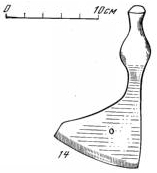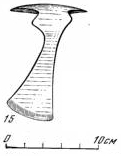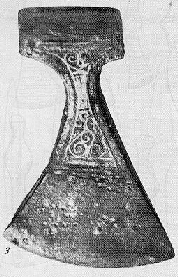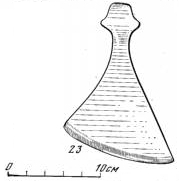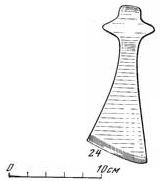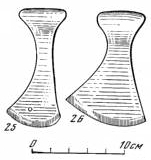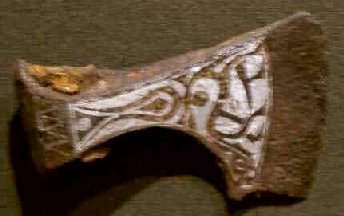
|
|
|---|
Last Page Update: Contact Copyright Information Main Page Structure of the Red Kaganate Gatherings, Events, . . . Historic Steppes Tribes Legends of the Nomads Flags and other Identifiers Clothing and Apearance Food and related Matters Armour Weapons and Combat Public Forum Resource Links
Editor: |
based on finds in the former Soviet Union
The use of battle axes had an ancient tradition in the Caucas. They are found in great numbers in Alan catacombs but are practicaly absent from Steppes Bulgar burials and early Khazar Kurgans. They then begin to apear in the 7th century among the semi-settled Khazars who left Saltov cremation burials.
The vast majority are small axes of "Chekan" type with a long narrow main blade and the back as a hammer (45, 46, 49-52, 54-57). A few have a secondary blade rather than a hammer (47, 48), and there is a very small number with a spike (53). Finaly, civilian "utility" axes at times apear in a military context (58, 59, 60).
The "Chekan" type axe (type I) continued to be the most popular type of battle axe in the areas of "the Rus" at least through the 14th century. It seems that the ideal purely military axe for Eastern Europe and Western Asia was light (chekan axes average 200-350 grams) with a long, narrow blade.
Following these "pure" battle axes, were those that most succeessfully combined the piercing power of the "pure" battle axe with the camp utility of a wider blade. The Type IV essentially extended the blade of the Type III, and by the 12th century, the Type IV-A simplified the back of the axe.
The "Type V" axe is most commonly found in the North of the Rus area. It is connected with Northern Europe and is termed
"Finno-Rus" based on the area and spread of development. A Type V-A, which, while similar to Type V, does not seem to be
geographically or chronologically connected, has a longer "tube" handle fitting. It developed in the 13th-14th century
and continues in traditional folk use to this day in Western Ukraine and Moldavia.
In the tenth century they are common throughout Northern Europe and are illustrated on the Bayeux tapestry in use by both the Anglo-saxon and Norman infantry. In Russia, these are mainly typical in the North and some are to be found in the burials of Farmers.
The Type VIII axe is quite uncommon, to be found solely in south-eastern Priladozhye and the teritories of the
Muroma.
While the "common wisdom" has been that the Axe is at best a secondary weapon for the Eurasian mounted warrior, some finds put this "wisdom" in doubt.
One such is the "Olen-Kolodetz" burial in the 13th-14th century Golden Horde. (Summary of the find with citation may be found at this Article by Dmitriy Ryaboy). The wealth and ornamentation of the burial as a whole, and the axe head itself make plain that the warrior buried there was of substantial importance, nevertheless No Saber (or sword of any kind) was found there. Axe Head is 14.2 cm long and the blade is 9.5 cm wide. See above article for more details.
|
Copyright
|
Contact us at [email protected] Where Author is specified, Copyright is retained by Author with express permission for use by "The Red Kaganate" organisation. Where Author is unspecified, Copyright is retained by Norman J. Finkelshteyn. |



